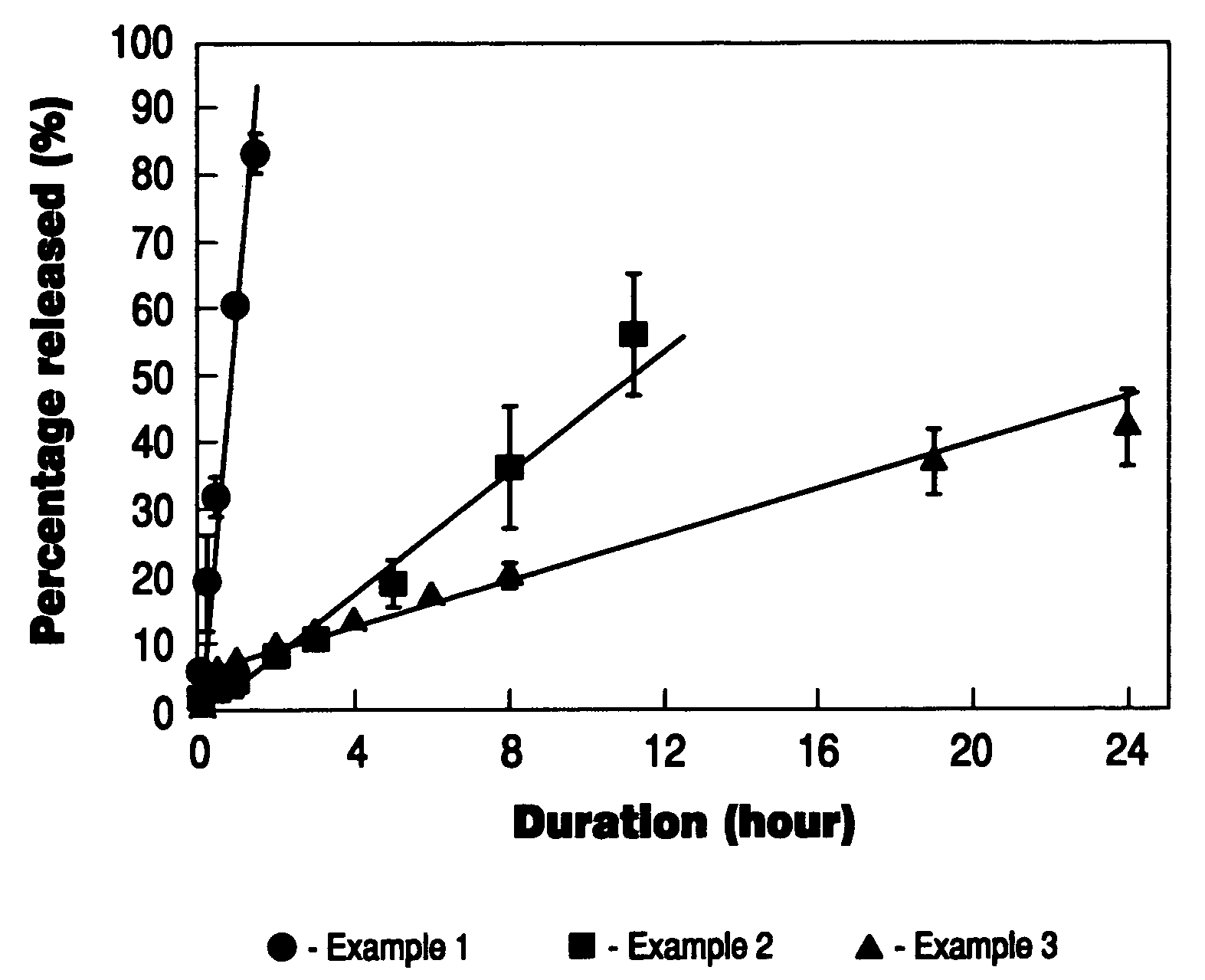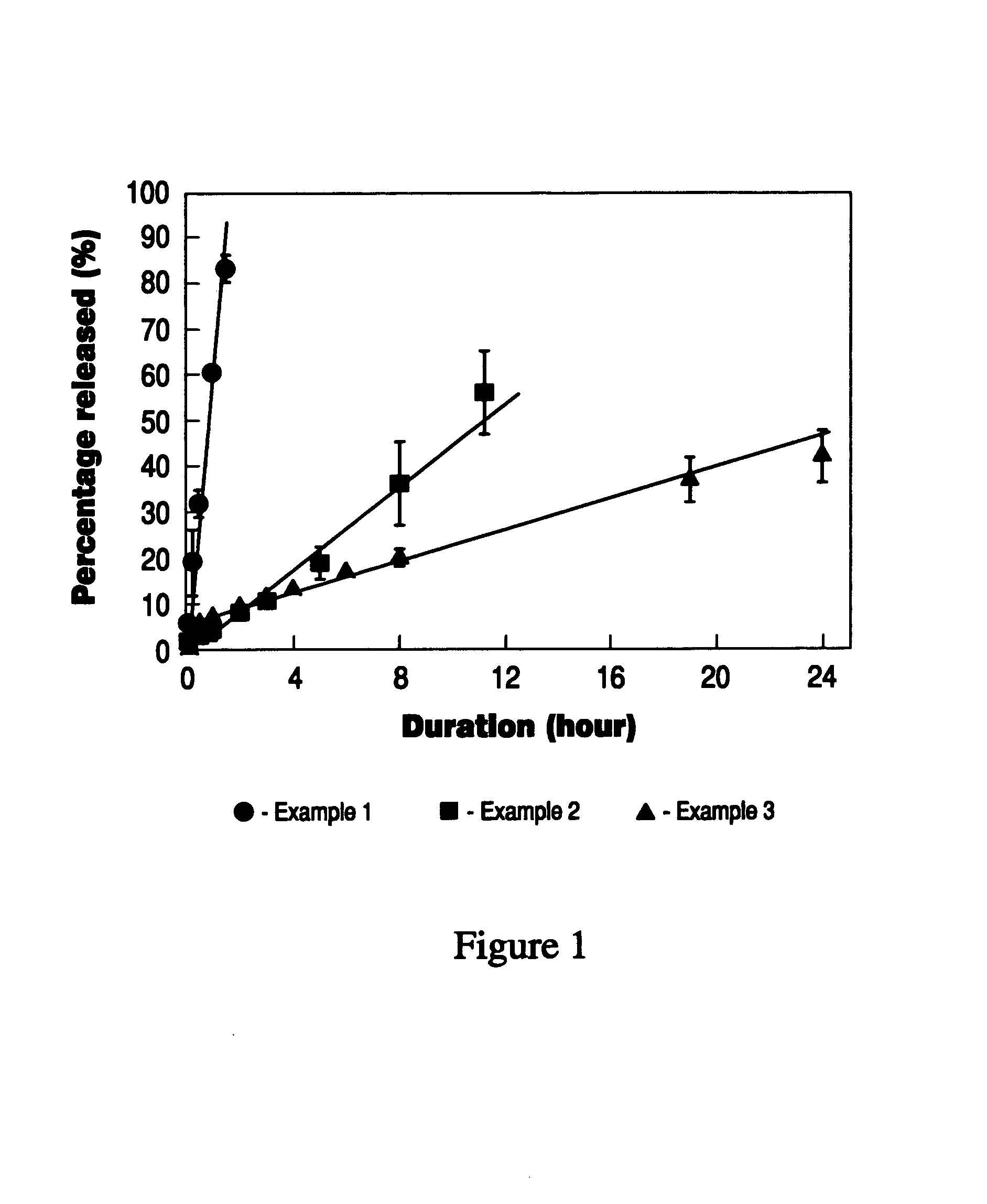Bioadhesive, closed-cell foam film, sustained release, delivery devices and methods of making and using same
- Summary
- Abstract
- Description
- Claims
- Application Information
AI Technical Summary
Benefits of technology
Problems solved by technology
Method used
Image
Examples
example 1
Bioadhesive Delivery Device Containing Estradiol
[0099]Polyvinylalcohol (nonionic polymer) and sodium alginate (anionic polymer) were dissolved in water. Hydro-ethanolic solution of sorbitan monooleate (swelling modifier) was then mixed into the polymer solution. The resulting solution was then spraydried to obtain unitorm bioadhesive microparticles. The microparticles were then well blended with estradiol (active agent), aspartame (taste modifier), benzoic acid (preservative), sodium EDTA (chelating agent), citric acid (buffering agent) and red #40 (coloring agent). Pepperming oil (taste modifier) and polyoxyethylene hydrogenated castor oil (foaming agent) were dispersed into propylene glycol (softening agent). The powder blend was fed into the hopper of a twin-screw extruder. The propylene glycol mixture was then introduced into the extruder to wet the powder mixture. High-pressure air was also introduced into the extruder to generate air bubbles in the wetted mixture. The foamy mi...
example 2
Bioadhesive Delivery Device Containing Estradiol
[0100]Gelatin (nonionic polymer) and sodium alginate (anionic polymer) were first dissolved in water. Hydro-ethanolic solution of polyoxyethylene castor oil (swelling modifier) was then mixed into the polymer solution under agitation. The resulting solution was then spray-dried to obtain uniform bioadhesive microparticles. The microparticles were then well blended with estradiol (active agent), aspartame (taste modifier), benzoic acid (preservative), sodium EDTA (chelating agent), citric acid (buffering agent) and red #40 (coloring agent). Peppermint oil (taste modifier) and polyoxyethylene hydrogenated castor oil (foaming agent) were dispersed into propylene glycol (softening agent). The powder blend was fed into the hopper of a twin-screw extruder. The propylene glycol mixture was then introduced into the extruder to wet the powder mixture. High-pressure air was also introduced into the extruder to generate air bubbles in the wetted ...
example 3
Bioadhesive Delivery Device Containing Estradiol
[0101]Methacrylic acid-methyl methacrylate copolymer (nonionic polymer) and carrageenan (anionic polymer) were first dissolved in water. Hydro-ethanolic solution of sorbitan monooleate (swelling modifier) was then mixed into the polymer solution under agitation. The resulting solution was then spray-dried to obtain uniform bioadhesive microparticles. The microparticles were then well blended with estradiol (active agent), aspartame (taste modifier), benzoic acid (preservative), sodium EDTA (chelating agent), citric acid (buffering agent) and red #40 (coloring agent). Peppermint oil (taste modifier) and polyoxyethylene hydrogenated castor oil (foaming agent) were dispersed into propylene glycol (softening agent). The powder blend was fed into the hopper of a twin-screw extruder. The propylene glycol mixture was then introduced into the extruder to wet the powder mixture. High-pressure air was also introduced into the extruder to generat...
PUM
| Property | Measurement | Unit |
|---|---|---|
| Temperature | aaaaa | aaaaa |
| Temperature | aaaaa | aaaaa |
| Temperature | aaaaa | aaaaa |
Abstract
Description
Claims
Application Information
 Login to View More
Login to View More - R&D
- Intellectual Property
- Life Sciences
- Materials
- Tech Scout
- Unparalleled Data Quality
- Higher Quality Content
- 60% Fewer Hallucinations
Browse by: Latest US Patents, China's latest patents, Technical Efficacy Thesaurus, Application Domain, Technology Topic, Popular Technical Reports.
© 2025 PatSnap. All rights reserved.Legal|Privacy policy|Modern Slavery Act Transparency Statement|Sitemap|About US| Contact US: help@patsnap.com


